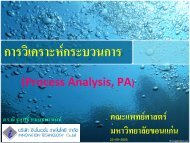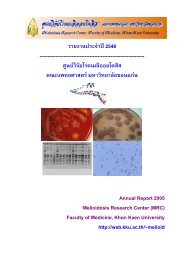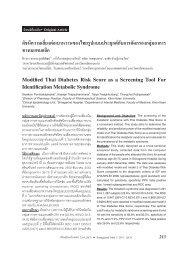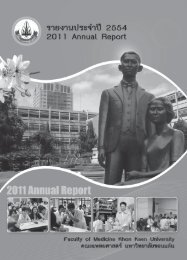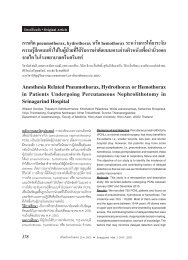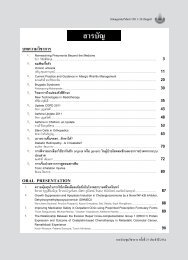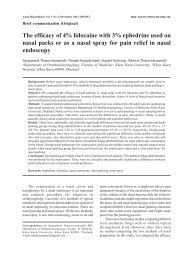Radiation dose from CT scanning: can it be reduced?
Radiation dose from CT scanning: can it be reduced?
Radiation dose from CT scanning: can it be reduced?
You also want an ePaper? Increase the reach of your titles
YUMPU automatically turns print PDFs into web optimized ePapers that Google loves.
16P. Trinavarat, et al.Table 3. Diagnostic reference levels (DRLs) for MD<strong>CT</strong> in adults.<strong>CT</strong> examination s<strong>can</strong> region <strong>CT</strong>DI w(mGy) <strong>CT</strong>DI v(mGy) DLP (mGy cm)UK European UK European UK EuropeanMS<strong>CT</strong> SS<strong>CT</strong> MS<strong>CT</strong> MS<strong>CT</strong> MS<strong>CT</strong> SS<strong>CT</strong>Head (acute posterior fossa 110 - 100 - - -stroke) cerebrum 65 - 65 - - -whole exam - 60 - 60 930 1050Thorax general lung 18 30 13 - - -liver 19 - 14 - - -whole exam - - - 10 580 650Thorax HR<strong>CT</strong> whole exam 50 35 7 10 170 280Abdomen whole exam 20 35 14 25 470 900(liver metastasis)Abdomen&pelvis whole exam 20 35 14 15 560 780(abscess)Chest, abdomen lung 16 30 12 - - -& pelvis abdomen & pelvis 20 35 14 - - -(lymphoma) whole exam - - - - 940 -Diagnostic reference level <strong>from</strong> Un<strong>it</strong>ed Kingdom in 2003 reported in 2006 [30]Diagnostic reference level <strong>from</strong> European guidelines published in 1999 [24]<strong>CT</strong>DI and DLP are <strong>dose</strong> parameters for QC.However, for assessment of <strong>can</strong>cer risks, an individualorgan-specific absor<strong>be</strong>d <strong>dose</strong> is more appropriate. Theeffective <strong>dose</strong> is another <strong>dose</strong> quant<strong>it</strong>y that is usedfor protection purposes [32], and <strong>it</strong> allows comparisonacross different types of <strong>CT</strong> studies and <strong>be</strong>tween <strong>CT</strong>and other imaging studies. So <strong>it</strong> is frequently mentionedin medical l<strong>it</strong>eratures.To obtain the effective <strong>dose</strong>, there are manymethods. It must <strong>be</strong> understood that most commonlyused methods calculate effective <strong>dose</strong> to a phantomrather than a patient. The most accurate butsophisticated methods need the help of medicalphysicists. Most of developing countries have notenough medical physicists. The easiest way tocalculate the effective <strong>dose</strong> for practical purpose isto multiply the displayed value of DLP by theconversion factor (conversion coefficient, or effective<strong>dose</strong> per DLP). The conversion factor is area-specifi<strong>can</strong>d age-specific, so we need a set of conversionfactors (Table 4). However, to make sure of the result,the displayed DLP needs to <strong>be</strong> verified by the QCprocess that needs <strong>s<strong>can</strong>ning</strong> a cylindrical acrylicphantom. These conversion factors are derived <strong>from</strong>a standard patient size (70kg man), <strong>from</strong> the estimatedradio-sens<strong>it</strong>iv<strong>it</strong>y of each organ (tissue weightingfactor), and <strong>from</strong> the assumed organs <strong>be</strong>ing includedin the <strong>s<strong>can</strong>ning</strong> volume. These num<strong>be</strong>rs are estimatevalid for a patient matching phantom and thus, willhave large error when applied to patients w<strong>it</strong>h higheror lower body weight.Table 4. Conversion factors specific for <strong>s<strong>can</strong>ning</strong> area and age group [30].Region of bodyEffective <strong>dose</strong> per DLP (mSv/mGy . cm) by agePediatricsAdult0 year old 1 year old 5 year old 10 year old (70 kg)Head 0.011 0.0067 0.0040 0.0032 0.0021Neck 0.017 0.012 0.011 0.0079 0.0059Head and Neck 0.013 0.0085 0.0057 0.0042 0.0031Chest 0.039 0.026 0.018 0.013 0.014Abdomen and pelvis 0.049 0.030 0.020 0.015 0.015Trunk 0.044 0.028 0.019 0.014 0.015




